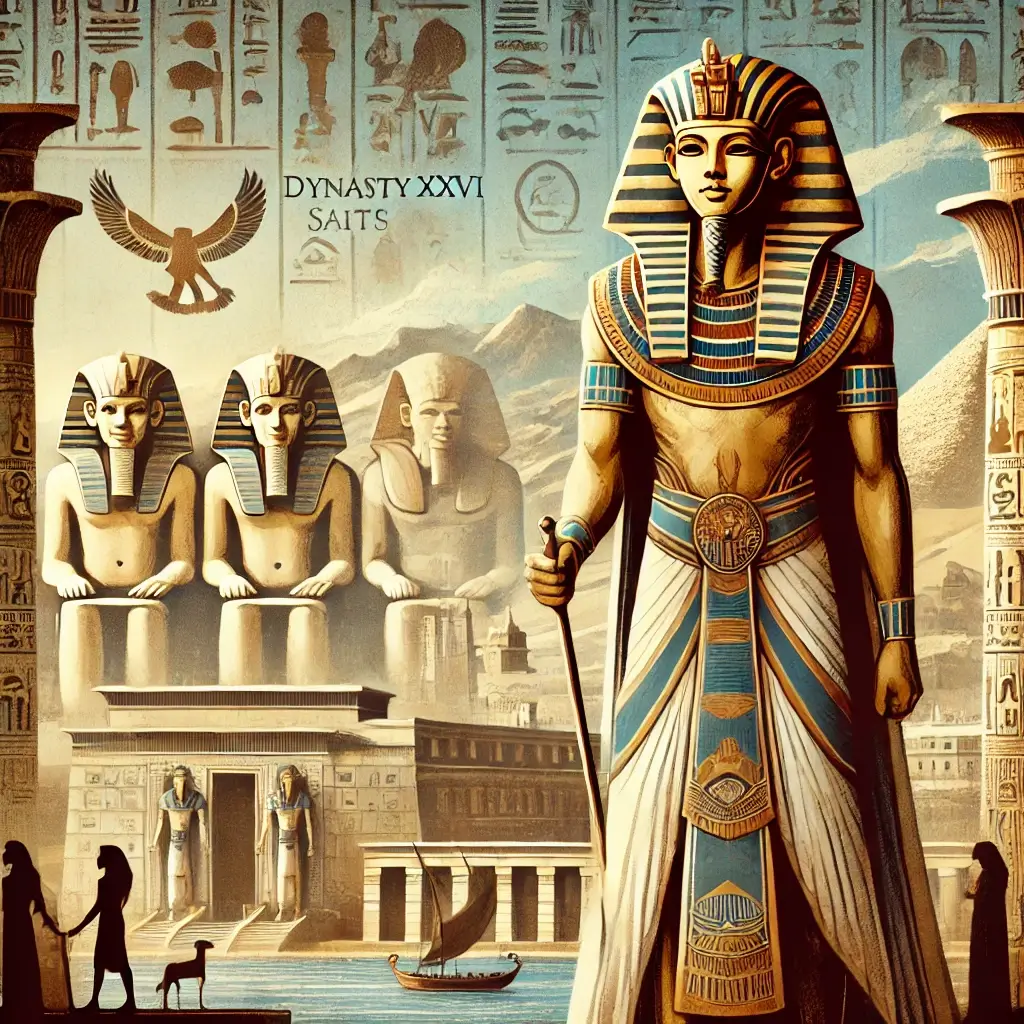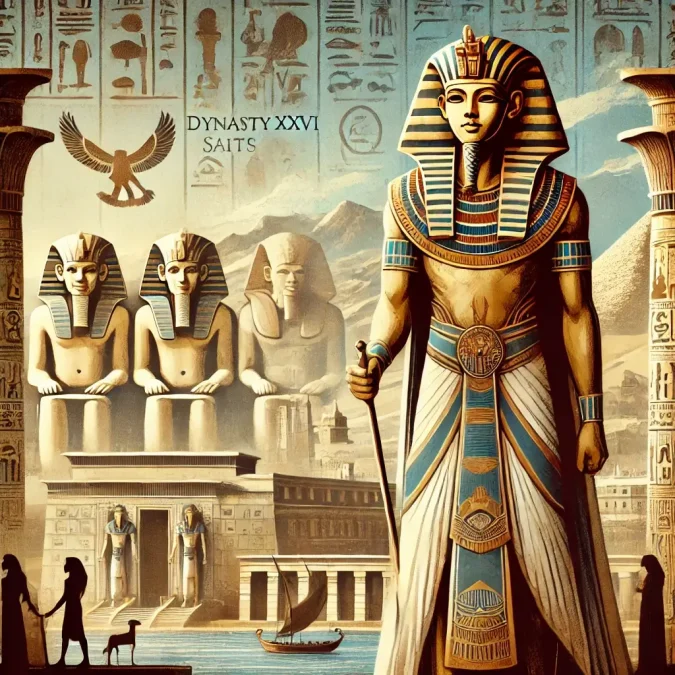
The Twenty-Sixth Dynasty of Egypt, also known as Dynasty XXVI, the 26th Dynasty, or the Saite Dynasty, was the last native dynasty of ancient Egypt before the Persian conquest in 525 BC. The dynasty ruled Egypt from 664 BC to 525 BC, and its reign is also referred to as the Saite Period, named after the city of Sais, where the pharaohs of this dynasty had their capital. The Twenty-Sixth Dynasty marks the beginning of the Late Period of ancient Egypt, a time characterized by efforts to revive Egypt’s former glory, strengthen its political and military power, and resist foreign invasions.
The Saite Dynasty was notable for its attempts to restore Egypt’s cultural heritage, its interactions with foreign powers such as the Assyrians, Babylonians, and Greeks, and its focus on economic prosperity and military strength. In this article, we will explore the historical context of the Twenty-Sixth Dynasty, provide an overview of its rulers, and examine the cultural, political, and military developments that occurred during its reign.
Historical Background of the Twenty-Sixth Dynasty
The Third Intermediate Period, lasting from approximately 1077 BC to 664 BC, was a time of political fragmentation and instability in Egypt. Following the decline of the New Kingdom, Egypt was divided among competing regional rulers, and centralized authority weakened significantly. By the late seventh century BC, the Assyrian Empire had established dominance over much of the Near East, including Egypt. The Assyrians appointed local rulers as vassals, and Egypt became subject to foreign influence and control.
The rise of the Twenty-Sixth Dynasty was closely linked to the decline of Assyrian power and the efforts of local leaders to assert their independence. Psamtik I, the founder of the Saite Dynasty, successfully unified Egypt and established himself as the ruler of a united kingdom. He also forged alliances with foreign powers, including the Greeks, who provided him with mercenaries and military support. The Saite rulers sought to restore Egypt’s prosperity and independence, embarking on ambitious building projects, expanding trade networks, and reinforcing the military.
The Rulers of the Twenty-Sixth Dynasty
The Twenty-Sixth Dynasty was ruled by a series of pharaohs who played important roles in shaping the history of this period. Below, we provide an overview of each ruler of the dynasty and their significant achievements.
1. Psamtik I (664–610 BC)
Psamtik I, also known as Psammetichus I, was the founder of the Twenty-Sixth Dynasty and the ruler who successfully reunited Egypt after a period of fragmentation. Psamtik I began his political career as a local ruler in Sais and, with the support of Greek mercenaries and alliances with other regional leaders, managed to consolidate power and establish himself as the ruler of a united Egypt.
Psamtik I’s reign was marked by efforts to strengthen Egypt’s military and restore its economic prosperity. He relied on Greek mercenaries to help defend Egypt’s borders, and he fostered strong diplomatic relations with the Greek city-states. Psamtik I also undertook several building projects, including the restoration of temples and monuments that had fallen into disrepair during the Third Intermediate Period. His efforts to restore centralized authority and promote economic growth laid the foundation for the success of the Twenty-Sixth Dynasty.
2. Necho II (610–595 BC)
Necho II, the son of Psamtik I, succeeded his father as pharaoh and continued the policies of military expansion and economic development. Necho II is perhaps best known for his ambitious projects, including an attempt to construct a canal connecting the Nile River to the Red Sea. This project, which predated the modern Suez Canal, was intended to facilitate trade and enhance Egypt’s economic prosperity.
Necho II also launched military campaigns in the Near East, seeking to expand Egypt’s influence in the region. He led an army to support the Assyrians against the rising Babylonian Empire, but his forces were ultimately defeated at the Battle of Carchemish in 605 BC. Despite this setback, Necho II continued to strengthen Egypt’s navy and promoted trade with foreign powers, including the Greeks and Phoenicians.
3. Psamtik II (595–589 BC)
Psamtik II, the son of Necho II, succeeded his father and ruled Egypt during a period of relative stability and prosperity. Psamtik II is known for his military campaign against the Kingdom of Kush to the south, which sought to eliminate the threat posed by the Nubian rulers who had previously controlled Egypt during the Twenty-Fifth Dynasty. The campaign was successful, and Psamtik II’s forces reached as far as Napata, the capital of the Kushite kingdom.
In addition to his military achievements, Psamtik II undertook several building projects and sought to promote the cultural revival of Egypt. He supported the construction and renovation of temples dedicated to the traditional gods of Egypt, including Amun, Ra, and Osiris. Psamtik II’s reign is also notable for the increased presence of Greek settlers in Egypt, who played an important role in the country’s economic and cultural life.
4. Apries (589–570 BC)
Apries, also known as Wahibre, succeeded Psamtik II and ruled Egypt during a time of increasing internal and external challenges. Apries sought to expand Egypt’s influence in the eastern Mediterranean and launched military campaigns in the Levant. He provided support to the city of Tyre during its rebellion against Babylonian rule and attempted to assert Egyptian control over the region. However, his efforts were met with limited success, and Egypt faced increasing pressure from the Babylonian Empire.
Apries’s reign was also marked by internal unrest, as discontent grew among the Egyptian population due to the reliance on foreign mercenaries and the perceived favoritism shown to Greek settlers. This unrest eventually led to a revolt, and Apries was overthrown by his general, Amasis, who established himself as the new pharaoh. Apries fled to Babylon but later returned to Egypt, where he was captured and killed.
5. Amasis II (570–526 BC)
Amasis II, also known as Ahmose II, was a former general who came to power after overthrowing Apries. Amasis was a popular ruler who sought to restore stability and promote economic growth in Egypt. He cultivated strong diplomatic and trade relations with foreign powers, particularly the Greeks, and encouraged Greek settlers to establish trading posts in Egypt. Under Amasis, the city of Naucratis became a major center of Greek commerce and culture in Egypt.
Amasis’s reign was marked by a period of prosperity and cultural revival. He undertook extensive building projects, including the construction of temples dedicated to the traditional gods of Egypt. Amasis also sought to strengthen Egypt’s military and prepared the country to resist foreign invasions. Despite his efforts, the growing power of the Persian Empire posed an increasing threat to Egypt, and Amasis’s death in 526 BC left Egypt vulnerable to Persian conquest.
6. Psamtik III (526–525 BC)
Psamtik III, the son of Amasis II, was the last ruler of the Twenty-Sixth Dynasty. His reign was brief and was dominated by the threat of Persian invasion. In 525 BC, the Persian king Cambyses II launched a military campaign against Egypt, and Psamtik III faced the challenge of defending his kingdom against the formidable Persian forces.
Despite his efforts to resist the Persian invasion, Psamtik III’s forces were defeated at the Battle of Pelusium, and the Persians captured Memphis, the capital of Egypt. Psamtik III was taken prisoner and later executed, marking the end of the Twenty-Sixth Dynasty and the beginning of Persian rule in Egypt. The fall of the Saite Dynasty marked the end of native Egyptian rule, as Egypt became a province of the Achaemenid Persian Empire.
Cultural and Economic Revival Under the Twenty-Sixth Dynasty
The Twenty-Sixth Dynasty was notable for its efforts to revive the cultural heritage of ancient Egypt and promote economic prosperity. The Saite rulers sought to restore the grandeur of Egypt’s past by undertaking ambitious building projects, fostering trade with foreign powers, and reviving traditional religious practices.
Building Projects and Religious Patronage
The rulers of the Twenty-Sixth Dynasty were devoted to the restoration and construction of temples dedicated to the traditional gods of Egypt. Psamtik I, Necho II, and their successors undertook extensive building projects, including the renovation of temples that had fallen into disrepair during the Third Intermediate Period. The Saite rulers emphasized the importance of piety and sought to legitimize their rule by associating themselves with the powerful priesthoods of Amun, Ra, and other major deities.
Amasis II, in particular, was known for his contributions to temple construction and his support for religious festivals and rituals. He restored the Temple of Neith in Sais, which was the center of the Saite Dynasty’s religious and political power. The emphasis on religious patronage helped to reinforce the authority of the Saite rulers and promote a sense of continuity with Egypt’s ancient past.
Trade and Economic Prosperity
The Twenty-Sixth Dynasty also focused on expanding Egypt’s trade networks and promoting economic growth. The Saite rulers established strong diplomatic and commercial relations with foreign powers, including the Greeks, Phoenicians, and Babylonians. Greek mercenaries played an important role in the Saite military, and Greek traders were encouraged to settle in Egypt, where they established the city of Naucratis as a major center of commerce.
Necho II’s ambitious project to construct a canal connecting the Nile River to the Red Sea was part of the Saite Dynasty’s efforts to enhance Egypt’s economic prosperity by facilitating trade with the Red Sea and the Indian Ocean. Although the project was not completed, it demonstrated the Saite rulers’ commitment to improving Egypt’s infrastructure and expanding its trade networks.
The Decline and Fall of the Twenty-Sixth Dynasty
The decline of the Twenty-Sixth Dynasty was closely linked to the growing power of the Persian Empire, which sought to expand its influence into the eastern Mediterranean and Africa. The Persian king Cambyses II launched a military campaign against Egypt in 525 BC, and the Egyptian forces, led by Psamtik III, were unable to withstand the Persian advance. The Battle of Pelusium was a decisive defeat for the Egyptians, and the Persians captured Memphis, effectively bringing an end to the Saite Dynasty.
The fall of the Twenty-Sixth Dynasty marked the end of native Egyptian rule and the beginning of Persian domination. Despite their efforts to strengthen Egypt’s military and promote economic growth, the Saite rulers were ultimately unable to resist the powerful Persian forces. The conquest of Egypt by the Persians marked the beginning of the Late Period, during which Egypt became a province of the Achaemenid Empire.
Conclusion
The Twenty-Sixth Dynasty of Egypt, also known as the Saite Dynasty, was the last native dynasty to rule Egypt before the Persian conquest in 525 BC. Founded by Psamtik I, the dynasty was characterized by its efforts to restore Egypt’s cultural heritage, strengthen its military, and promote economic prosperity. The rulers of the Saite Dynasty, including Necho II, Psamtik II, Apries, Amasis II, and Psamtik III, left a lasting impact on Egypt through their ambitious building projects, diplomatic relations with foreign powers, and commitment to reviving the traditions of ancient Egypt.
Despite their achievements, the Saite rulers faced significant challenges from external powers, particularly the expanding Persian Empire. The defeat of Psamtik III by Cambyses II marked the end of the Twenty-Sixth Dynasty and the beginning of Persian rule in Egypt. The legacy of the Saite Dynasty lies in its efforts to restore the grandeur of Egypt’s past and its contributions to the cultural and economic revival of the country during the Late Period.
